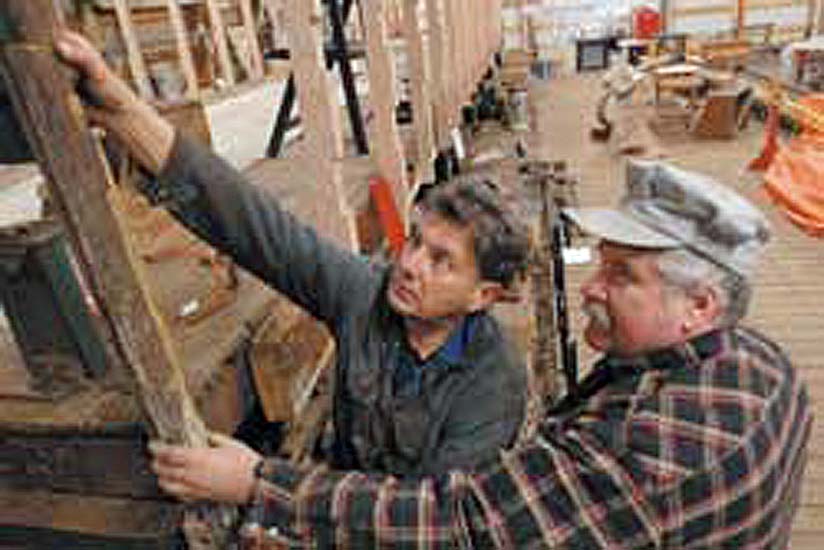



Cloverdale British Columbia - We're not exactly talking the bullet train to Tokyo.
But the dream of the Fraser Valley Heritage Railway Society is to one day offer a funky, functional community rail option along an existing route from Cloverdale to Scott Road SkyTrain station and on to Brownsville Bar.
They insist the dream can be realized - in baby steps at first.
The project got a push forward late last month when the City of Surrey granted up to $100,000 toward a project manager to work on the plan and continue to develop partnerships. The idea is to get a trial run, geared toward heritage tourism, running from Cloverdale to Sullivan Station (152nd Street at 64th Avenue) within the next couple of years.
Society secretary Allen Aubert said this week Peter Holt has been retained for that managerial role. (Holt, who just ended his tenure as executive director of the Surrey Board of Trade, has been involved with the project for several years.)
The idea also got a financial boost from an unexpected source this week when the Surrey Foundation handed over $14,000 from proceeds of a class-action lawsuit in Ontario. The settlement money was specifically earmarked for projects related to community transportation.
The society has spent the past 18 months restoring a heritage electric train purchased from a rail museum in California, and is on the brink of an announcement about a second rail car.
They say the Duke of Connaught, now in Oregon, will hopefully be repatriated to Canada soon as the last remaining car of its type anywhere. There were, at one time, some 80 such cars operating on an electric rail system in the Fraser Valley, moving people and goods from Chilliwack to the coast. When the overhead-wire-powered system was decommissioned in the late 1950s, however, most of those cars were scrapped or burned.
Those that did survive, such as the society's BCER Interurban 1225, require extensive rehabilitation. That includes replacing all the structural uprights and windows, recasting brass fittings and having unique items like the rattan seats remade from scratch.
It's all quite costly, but much of that expense is being underwritten with labour by society volunteers. In recent weeks they've made custom oak structural supports to replace the rotted originals, and are getting set to work on windows, doors and other parts of the car. The mechanical base is still sound, and in fact the train was still operating at the museum when it was purchased in 2005.
The heritage tourism trip would also be run by volunteers, and then only in summer - but the society feels it can demonstrate how community rail would work on a longer route and with a full fleet.
"This would be the only (train) operating on its original track," points out Aubert. "The city is keen to show people that the trains can be used as inter-community shuttles."
Because the wires are long gone, the society plans to retrofit a baggage car with hydrogen-powered cells to make the passenger car go. Because the province of B.C. is promoting the idea of a "hydrogen highway," that effort could see support from higher levels of government.
"It's absolutely environmentally-friendly (technology)," says Aubert.
Holt says there has been some doubtful information circulated about costs after studies by TransLink - but he questions the notion the rail route would be prohibitively expensive to operate.
He points out TransLink's $600-million estimate included the assumption the trains would require two dedicated tracks. He says the heritage cars won't require more than a basic upgrade of the existing freight rail bed.
Holt says a more recent study shows community rail can be accomplished along the whole 20-kilometre route for about $105 million - or just $5 million a kilometre. That compares with an average cost for North American light-rail transit systems of $35 million per kilometre, and isn't much higher than the per-kilometre cost of TransLink's RAV line.
Holt says the key issues going forward are getting the co-operation of BC Hydro, which owns the line, and Southern Railway, the Washington-based rail group that continues to run a limited freight service along the planned route.
Then, of course, there's the money. The city knows it doesn't have the resources to go it alone, but is supportive of using the heritage service as a jumpstart to full-scale community rail.
"The heritage part of it, (Mayor Dianne Watts) recognizes, is a precursor," notes Holt. "It will alert people that the line is there.
"It will get people thinking, So I can get on a train in Cloverdale, and it connects with Scott Road SkyTrain?"
Holt says that dream of community rail isn't far-fetched, and a heritage run also isn't far off if community and government support is there.
"We can get the first train on the track
probably by the end of 2008," he says, with a trial run in operation by the summer of 2009.
Author unknown.